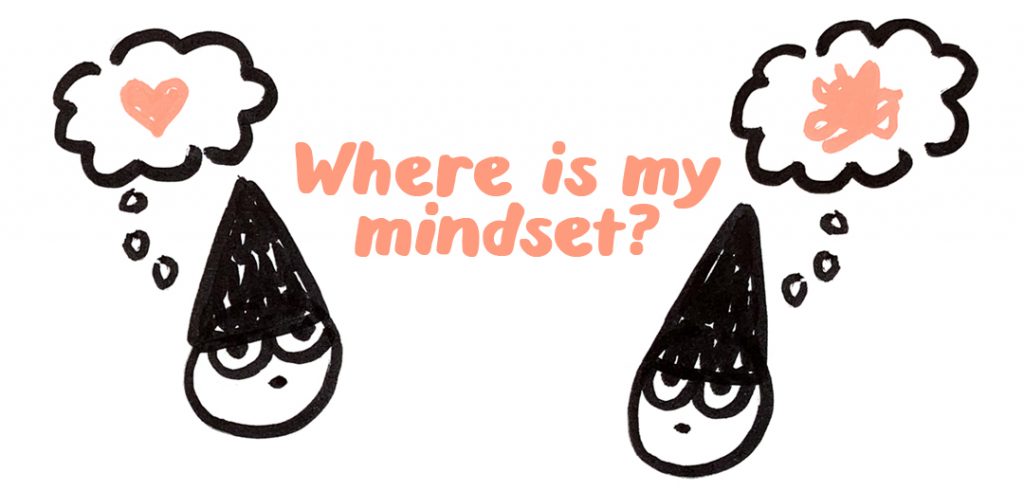
Note: This is an ongoing series exploring my working theory of Artistic Intelligence. You can read the first essay in this series here. My current definition of Artistic Intelligence (AQ) is the ability to guide our thinking to change our behavior, so we can make our own art.
Here’s a Recap!
The ultimate goal of Artistic Intelligence is to learn how to manage unhelpful mindsets so don’t get stuck in them. With practice, we can identify an unhelpful mindset quickly and move right through it, so we can get back to making art.

Mindset Identification Guide
Previously, I developed a list of 15 Creative Mindsets pairs, which I have now distilled down to 9 pairs. This essay is an identification guide to help you recognize when you’re in one these creative mindsets.
Click a mindset below to jump right to it!
- Fragile or Resilient
- Fearful or Brave
- Rigid or Flexible
- Doubtful or Confident
- Impatient or Patient
- Self-Critical or Self-Compassionate
- Perfectionist or In Flow
- External Validation or Internal Validation
- Overthinking or Letting Go
1. Fragile or Resilient
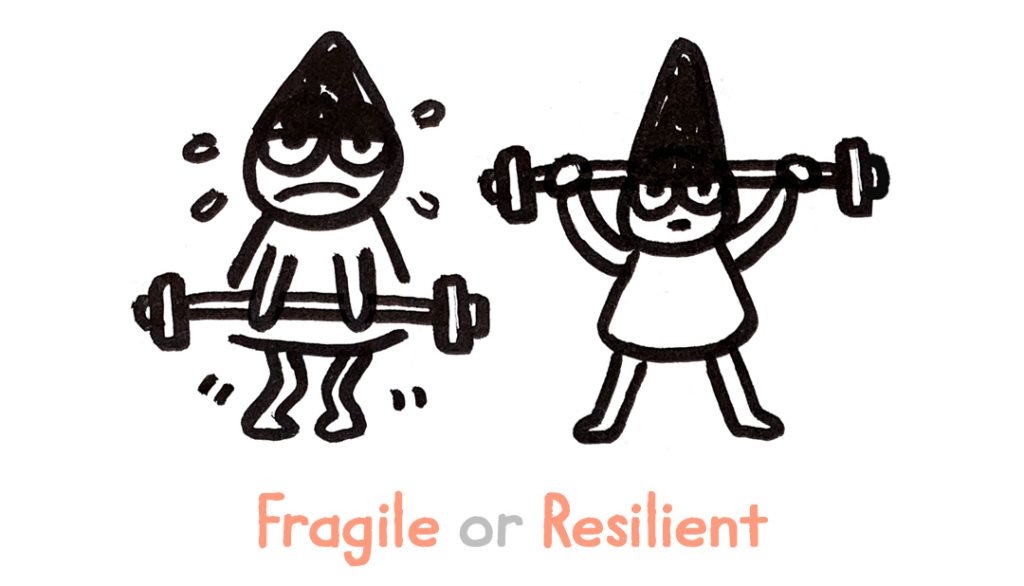
When we feel FRAGILE while making art…
Definition: Fragility is the quality of being easily broken.
When it Happens: A Fragile mindset can take over when we encounter challenges with our art. It often seeps in we feel disappointed in our artistic abilities and what we’ve created.
Associated Feelings:
- Overwhelm
- Despair
- Anger
- Weakness
- Self-criticism
- Disappointment
Associated Thoughts:
- “I wish I was better at drawing.”
- “I can never draw ______ right.”
- “I always mess up my drawing.”
- “I’ll never find my artistic style.”
- “Why am I even trying to draw?”
Associated Actions
- Crumbling when things change or become difficult.
- Wallowing in negative thoughts about your art and yourself
- Punishing yourself for making mistakes
- Responding defensively to comments on your art
- Hiding from or giving up on challenges
- Not being able to make art; Creative Block
- Giving up when issues feel too big
- Losing interest and enthusiasm for drawing
- Not making art
When we feel RESILIENT while making art…
Definition: Resilience is the ability to bounce back and adapt in the face of challenges.
When it Happens: A Resilient mindset can take over when we encounter challenges with our art. It often blooms when we feel compassion towards our artistic abilities and what we’ve created.
Associated Feelings:
- Balance
- Hope
- Peace
- Strength
- Self-compassion
- Acceptance
Associated Thoughts:
- “I can work at getting better at drawing.”
- “I’m going to experiment drawing ____.”
- “Sometimes I make mistakes.”
- “I can figure this out.”
- “My art serves a purpose.”
Associated Actions
- Adapting when things change or get hard.
- Cultivating positive thoughts about your art and yourself
- Accepting mistakes you make as part of the creative process
- Listening to comments on your art, and calmly discarding what you don’t agree with
- Approaching and overcoming challenges
- Making art freely
- Taking a break or starting over when issues get too big
- Rekindling enjoyment and love of drawing
- Making art
2. Fearful or Brave
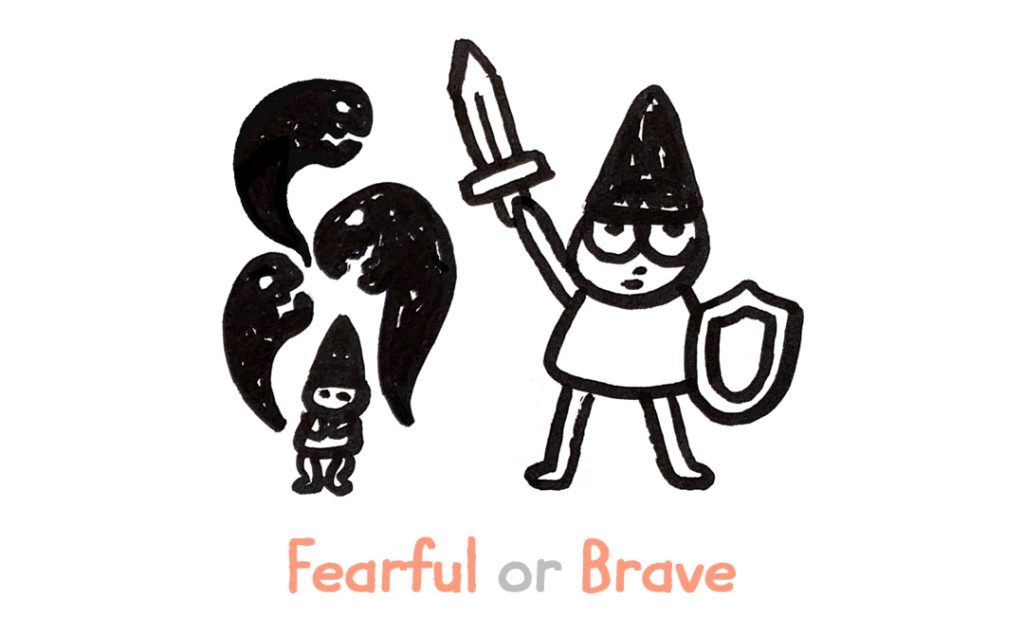
When we feel FEARFUL while making art…
Definition: Fear is the feeling of anxiety about an undesirable outcome.
/the inability to face fear and endure risk.
When it Happens: A Fearful mindset can take over when we worry about how our art will turn out or what others will think of it. It often seeps in when we think of drawing or when we sit down to draw.
Associated Feelings:
- Anxious
- Uneasy
- Worried
- Nervous
- Hesitant
- Reluctant
Associated Thoughts:
- “I’m worried I won’t be able to draw what’s in my head.”
- “I’m nervous about what people will think of this drawing.”
- “I’m afraid I’ll mess up this drawing.”
Associated Actions
- Coming up with excuses to not draw, avoiding making art
- Endlessly scrolling through references
- Comparing yourself to other artists
- Losing interest and enthusiasm for drawing
- Not making art
When we feel BRAVE while making art…
Definition: Bravery is the ability to face fear and endure risk.
When it Happens: A Brave mindset can take over when we encounter fear with our art. It often blooms when we accept that mistakes are a part of the creative process.
Associated Feelings:
- Daring
- Adventurous
- Audacious
- Gutsy
- Resilient
Associated Thoughts:
- “I’m not sure I can draw this, but I’m going to give it a go!”
- “Maybe people won’t like this, but I’m going to take the risk!”
- “I may mess up this drawing, but I’ll learn something even if I do.”
Associated Actions
- Attempting to draw anything
- Moving past procrastination
- Getting inspired by other artists
- Rekindling enjoyment and love of drawing
- Making art
3. Rigid or Flexible
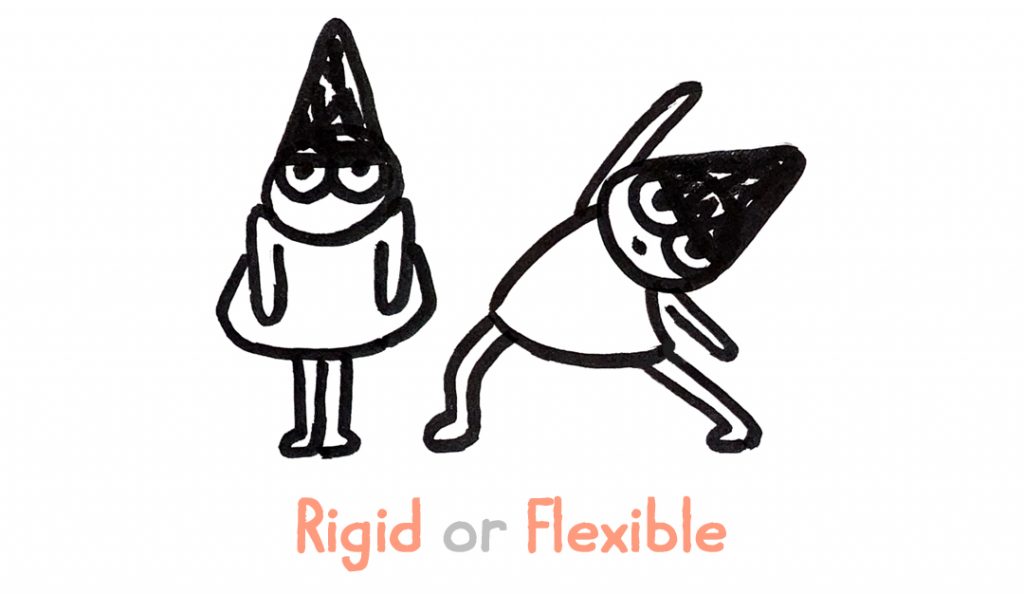
When we feel RIGID while making art…
Definition: Rigidity is the inability to change or adapt.
When it Happens: A Rigid mindset can take over when we desire rules and guaranteed outcomes with our art. It often seeps in when we try to control the outcome of our art before we even begin.
Associated Feelings:
- Tight
- Restricted
- Blocked
- Frustrated
Associated Thoughts:
- “I wish I could just draw this the ‘right’ way.”
- “I have to draw accurate anatomy and perspective.”
- “I need to follow a tutorial before I can try to draw this.”
Associated Actions
- Only drawing from tutorials and step-by-step guides
- Only able to draw with a reference image
- Becoming creatively blocked
- Not wanting to draw
- Losing interest and enthusiasm for drawing
- Not making art
When we feel FLEXIBLE while making art…
Definition: Flexibility is the ability to change and adapt.
When it Happens: A Flexible mindset can take over when we approach our art with an open mind. It often seeps in when we allow ourselves to make mistakes and follow happy mistakes.
Associated Feelings:
- Loose
- Free
- Creative
- Content
Associated Thoughts:
- “I can find my own way of drawing this.”
- “I can explore and experiment with many ways of drawing.”
- “I can try to draw something without knowing what I’m doing.”
Associated Actions
- Attempting to draw anything
- Discovering the way you enjoy drawing
- Developing your unique way of drawing
- Desiring to draw
- Rekindling enjoyment and love of drawing
- Making art
4. Doubtful or Confident
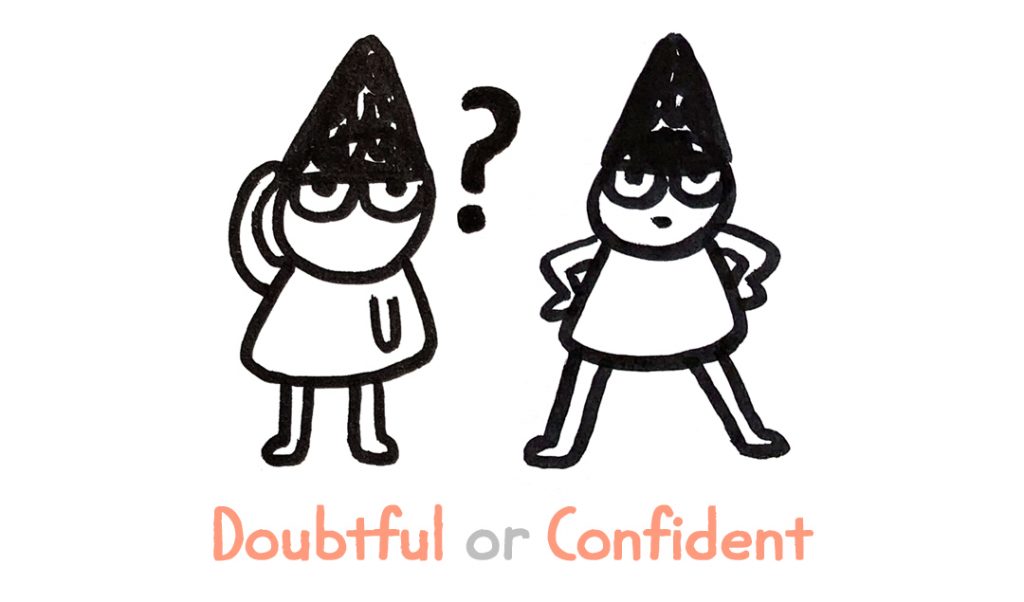
When we feel DOUBTFUL while making art…
Definition: Doubt is feeling uncertain about yourself and your abilities.
When it Happens: A Doubtful mindset can take over when we question whether we have what it takes to make art. It often seeps in we compare ourselves to other artists.
Associated Feelings:
- Hesitation
- Worry
- Confusion
- Pessimism
- Unworthy
- Imposter Syndrome
Associated Thoughts:
- “I can’t draw this.”
- “I’m not a good enough artist.”
- “I’m never going to get better at drawing.”
- “I don’t have any talent.”
- “This drawing isn’t worth sharing.”
Associated Actions
- Not able to give yourself credit
- Unable to see the good things in your art
- Losing motivation to draw
- Beliving we’ll never achieve our goals
- Comparing yourself to other artists
- Looking for external validation (likes on social media)
- Not seizing opportunities
- Not attempting your dreams
- Standing in our own way
- Not finishing pieces of art
- Losing interest and enthusiasm for drawing
- Not making art
When we feel CONFIDENT while making art…
Definition: Confidence is ability to believe in and trust yourself and abilities.
When it Happens: A Confident mindset can take over when we adopt a positive view our art. It often blooms when we trust that we can learn and grow.
Associated Feelings:
- Calm
- Relaxed
- Optimistic
- Trusting
- Assured
Associated Thoughts:
- “I can draw this.”
- “I’m good enough.”
- “I’m getting better at drawing.”
- “Talent doesn’t exist—I’m learning how to draw.”
- “This drawing is worthwhile on its own.”
Associated Actions
- Give yourself credit for growth and achievements
- Able to see the good things in your art
- Motivated to draw
- Believing you can achieve your goals with time and hard work
- Being inspired by other artists
- Looking for internal validation
- Seizing opportunities
- Following your dreams
- Pushing yourself forward
- Completing pieces of art
- Rekindling enjoyment and love of drawing
- Making art
5. Impatient or Patient
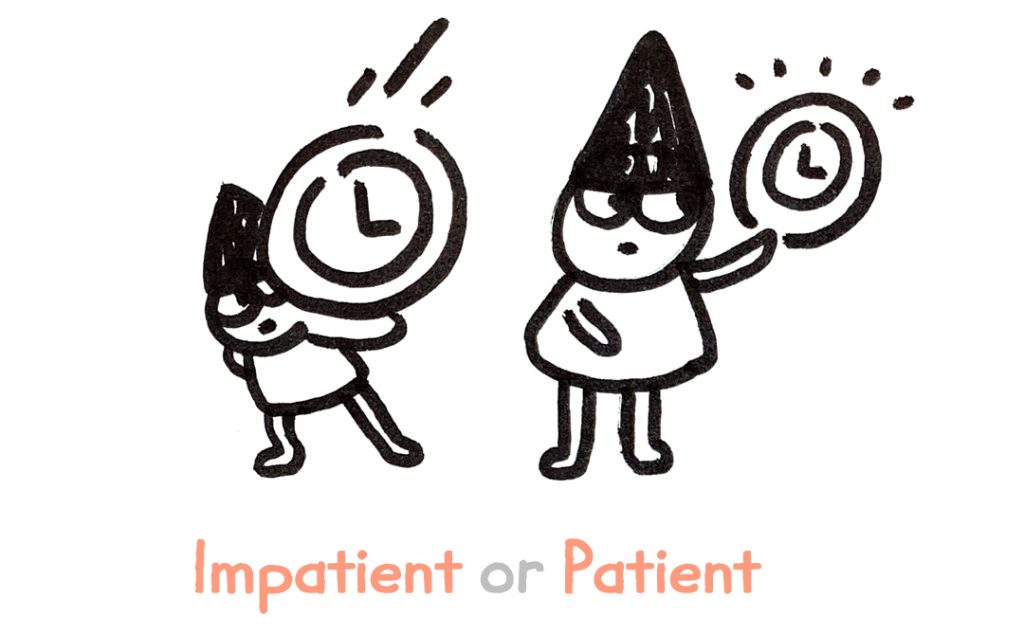
When we feel IMPATIENT while making art…
Definition: Impatience is the quality of being quickly irritated with problems.
When it Happens: An Impatient mindset can take over when we want instant success with our art. It often seeps in we feel like we’re not making progress.
Associated Feelings:
- Frustrated
- Angry
- Grumpy
- Tense
- Restless
- Regret
- Perfectionism
Associated Thoughts:
- “So-and-So can draw so much better than me.”
- “I should be drawing better than this already.”
- “I should know what my artistic style is by now.”
- “I’ve wasted so much time, I could be so much better.”
Associated Actions
- Only seeing the mistakes in your art.
- Not able to move past mistakes in your art.
- Unwilling to put in the time and hard work to improve.
- Speeding through drawing, not noticing how you’re feeling
- Expect perfection every time you draw.
- Not acknowledging the growth in your art.
- Thinking about the future, rather than what you’re currently drawing
- Comparing yourself to other artists—expecting to be where they are now.
- Losing interest and enthusiasm for drawing
- Not making art
When we feel PATIENT while making art…
Definition: Patience is the ability to tolerate problems without getting irritated.
When it Happens: A Patient mindset can take over when we accept that the artistic journey is ongoing and we are always learning and growing. It often blooms when we accept where we currently are.
Associated Feelings:
- At peace
- Content
- Loose
- Acceptance
Associated Thoughts:
- “I could learn a lot from So-and-So.”
- “I can get better if I keep drawing.”
- “I’ll develop my artistic style the more I draw.”
- “I can’t go back in time, but I can start drawing now.”
Associated Actions
- Recognizing mistakes and learning from them
- Making mistakes and trying again
- Accepting mistakes
- Devoting your time and hard work to improve
- Accepting that mistakes are part of the creative process and growth
- Acknowledging how you’ve improved in your art over time
- Slowing down and appreciating what you’re drawing right now
- Inspired by other artists’ paths
- Rekindling enjoyment and love of drawing
- Making art
6. Self-Critical or Self-Compassionate
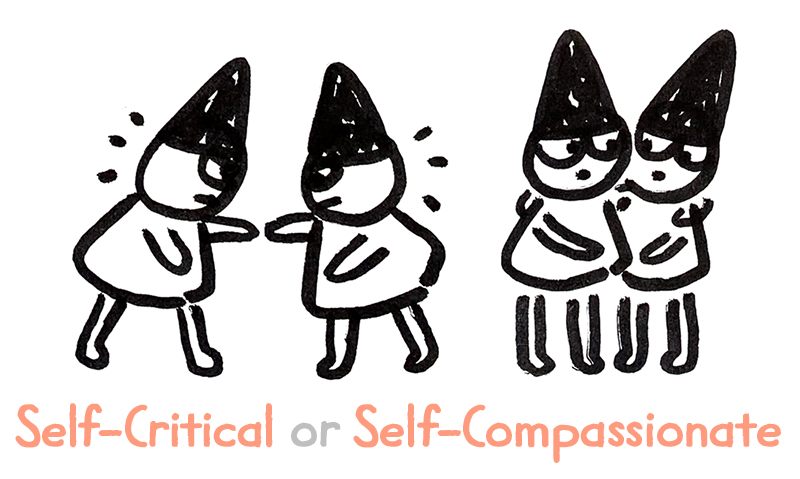
When we feel SELF-CRITICAL while making art…
Definition: Self-Criticism is the quality of being hard on yourself when faced with flaws.
When it Happens: A Self-Critical mindset can take over when we are chronically disapproving of our art. It often seeps in when we feel that our art must be perfect.
Associated Feelings:
- Perfectionism
- Criticism
- Disappointed
- Pessimistic
- Frustration
Associated Thoughts:
- “This drawing is terrible.”
- “I’m such a bad artist.”
- “I’m not an artist.”
- “Everything I draw is horrible.”
Associated Actions
- Only able to see bad parts of your art.
- Focused on the outcome, the final product.
- Inner Critic takes over.
- Drawing becomes unenjoyable.
- Not sharing your art with anyone.
- Tearing up or scribbling through drawings.
- Losing interest and enthusiasm for drawing
- Not making art
When we feel SELF-COMPASSIONATE while making art…
Definition: Self-compassion is the ability to be kind to yourself when faced with flaws.
When it Happens: A Self-Compassionate mindset can take over when we accept our flaws and mistakes as part of the process. It often seeps in when we relax and let go.
Associated Feelings:
- Joy
- At peace
- Confident
- Creative
- Innovative
- Understanding
- Kind
- Gentle
- Accepting
Associated Thoughts:
- “I’m having a hard time with this piece of art. How can I care for myself?”
- “Everyone makes mistakes, it’s part of the creative process.”
- “I can share my art with those I choose.”
- “I’m finding the way I like to draw.”
- “I may have messed up this piece, but I can try again tomorrow.”
Associated Actions
- React to mistakes with kindness and acceptance
- Able to share art with others
- Satisfied with your art
- Enjoy drawing
- See past individual mistakes to appreciate the overall artwork
- Motivated to draw because you are gently learning and growing
- Rekindling enjoyment and love of drawing
- Making art
7. Perfectionist or In Flow
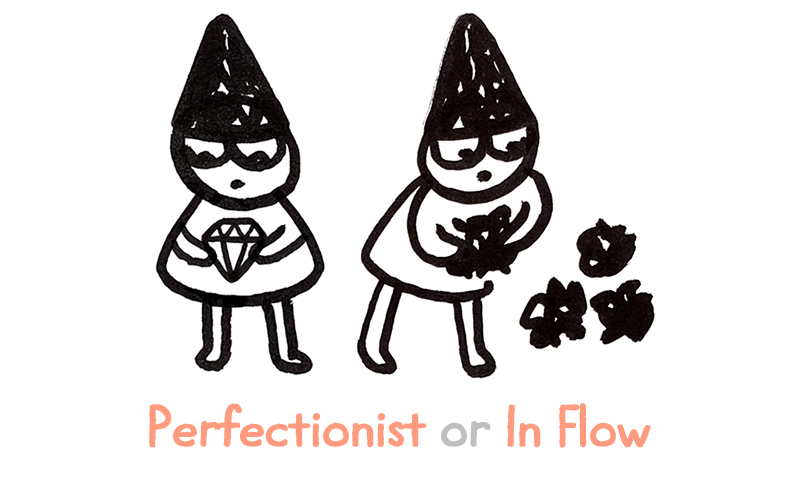
When we feel PERFECTIONIST while making art…
Definition: Perfectionism is the inability to accept anything other than perfection.
When it Happens: A Perfectionist mindset can take over when we hold unrealistically high expectations for our art. It often seeps in before we even begin.
Associated Feelings:
- Insecurity
- Stressed
- Dissatisfaction
- Tense
- Doubt
- Unworthy
- Shame
Associated Thoughts:
- “I need to know how do draw this perfectly before I can try.”
- “My finished drawing is more important than the process of drawing.”
- “I can never finish a piece of art.”
- “I’m not good enough today and I never will be.”
Associated Actions
- Not attempting something new
- Always disappointed in your art
- Difficult to enjoy drawing
- Taking an excessive amount of classes/tutorials before trying to draw something
- Never finishing a piece of art
- Procrastinate drawing
- Spend more time erasing than drawing
- Seeing one mistake as ruining the entire piece
- Easily jealous of other artists’ success
- Comparing yourself to others unrealistically
- Harsh criticism leads to avoiding drawing
- Unmotivated to draw because you can’t do it perfectly
- Unable to accept the process of learning
- Losing interest and enthusiasm for drawing
- Not making art
When we feel ACCEPTING while making art…
Definition: Acceptance is the ability to unconditionally value all parts of yourself.
When it Happens: An Accepting mindset can take over when we accept our strengths and flaws. It often seeps in when we see ourselves on a continual path of growth.
Associated Feelings:
- Trusting
- Relaxed
- Content
- Calm
- Fulfilled
- Confident
- Self-compassionate
- Worthy
Associated Thoughts:
- “I can try to draw this.”
- “The process of drawing is more important than the final product.”
- “This piece of art is good enough to be finished.”
- “I’m good enough.”
- “I tried my best today and I can try again tomorrow.”
Associated Actions
- Trying new things and embracing challenges
- Able to be satisfied with your art
- Easy to enjoy drawing
- Able to call a piece finished
- Able to sit down and start drawing
- Doesn’t erase mistakes often
- Can accept mistakes and either work with them or try again
- Inspired by other artists’ success
- Belief that you are improving and growing
- Growing in a sustainable way
- Striving for improvement and achievement in a healthy way
- Motivated to draw because you enjoy the process
- Rekindling enjoyment and love of drawing
- Making art
8. External or Internal Validation
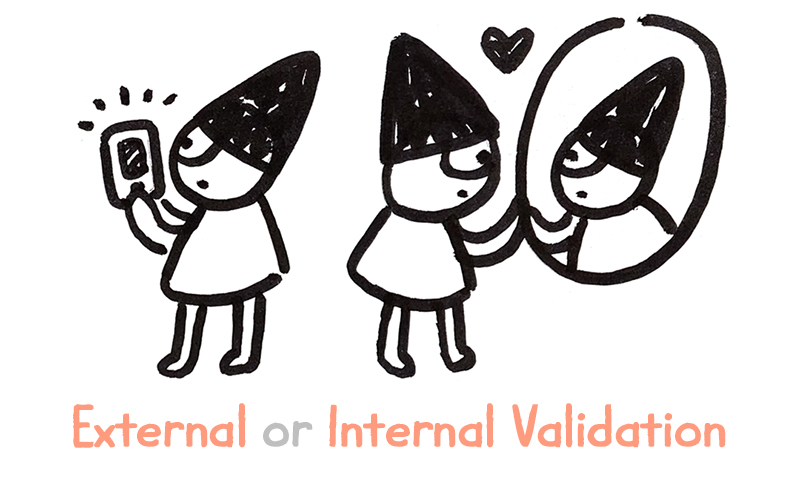
When we feel EXTERNAL VALIDATION while making art…
Definition: External Validation is the quality of tying your self-worth to what others think.
When it Happens: An External Validation mindset can take over when we feel we need approval of our art from others to feel good about it. It often seeps in when we use social media.
Associated Feelings:
- Insecurity
- Worry
- Anxious
- Disappointment
- Lost
- Confused
- Frustrated
Associated Thoughts:
- “My art didn’t get many likes, that means it’s bad.”
- “I don’t have many followers, that means my art is bad.”
- “I don’t know how to draw art that feels like me.”
Associated Actions
- Always viewing your art as not good enough
- Tying your art’s worth to how many likes it gets on social media
- Comparing how many social media followers you have to other artists
- Trying to figure out what other people like and making art that way
- Creating inauthentic art
- Dwelling on mistakes
- Losing interest and enthusiasm for drawing
- Not making art
When we feel INTERNAL VALIDATION while making art…
Definition: Internal Validation is the quality of tying your self-worth to what you think.
When it Happens: An Internal Validation mindset can take over when we are able to see and reflect on our art and give ourselves approval. It often seeps in when we enjoy the process of making.
Associated Feelings:
- Self-assured
- Relaxed
- Calm
- Content
- Motivated
- Confident
- Proud
Associated Thoughts:
- “I like this piece of art, so I don’t care if others like it or not.”
- “How many followers I have doesn’t matter to me.”
- “I’m discovering my unique style with every piece of art I make.”
Associated Actions
- Able to reflect on and identify the good in your art
- Able to see the value in your work on your own
- Not caring how many likes your art gets on social media
- Not caring how many followers you have on social media
- Making the art you enjoy making and like most
- Creating authentic art
- Accepting mistakes as part of the creative process
- Rekindling enjoyment and love of drawing
- Making art
9. Overthinking or Letting Go
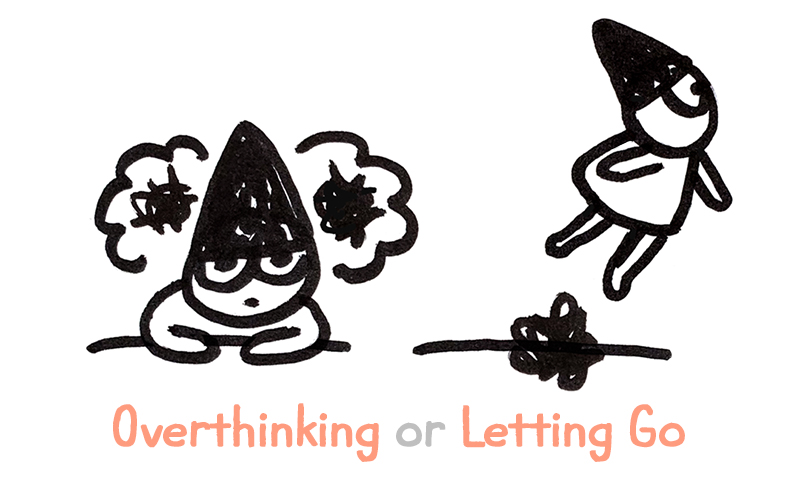
When we OVERTHINK while making art…
Definition: Overthinking is the quality of excessively reasoning, rationalizing, or intellectualizing.
When it Happens: An Overthinking mindset can take over when we continuously worry or fret about what we’re doing while making art. It often seeps in we feel the need to draw something the “right” way.
Associated Feelings:
- Worried
- Stressed
- Anxious
- Uneasy
- Overwhelmed
- Distracted
- Hesitant
- Self-Doubt
- Perfectionism
- Uptight
- Nervous
Associated Thoughts:
- “I’m not sure if I’m doing this right.”
- “This is not going well.”
- “I need to be able to control my drawing more.”
- “I’m taking too long, I butchered this drawing, this isn’t what I wanted to draw.”
Associated Actions
- Constantly judging your art while you’re making it
- Fixating on mistakes
- Trying so hard you tighten up
- Giving yourself lots of instructions
- Difficult to get yourself to sit down and draw
- Not sharing your art because you think it’s not right
- Losing interest and enthusiasm for drawing
- Not making art
When we LET GO while making art…
Definition: Letting Go is the ability to relinquish one’s grip.
When it Happens: A Letting Go mindset can take over when we approach our art with an open mind. It often seeps in when we don’t feel pressured or burdened with expectations.
Associated Feelings:
- Calm
- Playful
- Quiet
- Creative
- Spontaneous
- Focused
- Free
Associated Thoughts:
- “I’m doing this.”
- “Oops, I messed up. Oh well, I’ll keep going.”
- Quieted thoughts
Associated Actions
- Being absorbed in the creative process
- Your art seems to make itself
- You’re able to follow your hand and see what happens
- Erasing less, accepting mistakes and moving on
- Rekindling enjoyment and love of drawing
- Making art
Whew!
I hope this guide can help you identify what mindset you’re in next time you start drawing. And before you start beating yourself up when a Unhelpful mindset seeps in—remember! All these mindsets are normal and natural, and we’ll probably never be able to totally get rid of them.
The ultimate goal of Artistic Intelligence is to learn how to manage our unhelpful mindsets so don’t get stuck in them. With practice, we can get to the point where we’re able to identify an unhelpful mindset quickly and just move right through to get back to making art.
And that’s what’s comin’ up next!
Which creative mindset are you in right now?
Now that we’ve covered the mindsets, you can start trying to identify them while you’re creating. Which mindsets do you think you’ve been experiencing lately?
Join the group discussion in Might Could Studiomates or reply to this email to share your thoughts!

